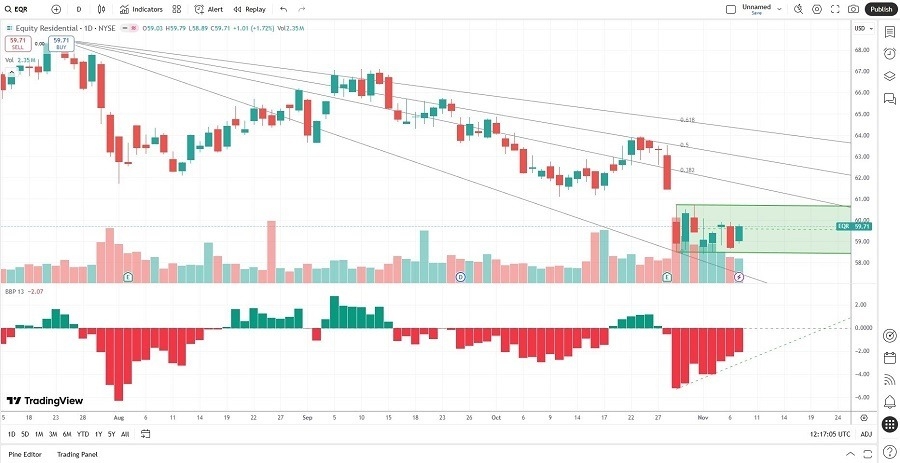Real estate has always been an exciting long-term investment, and it should be part of a well-diversified portfolio. Real estate investments can provide an inflation hedge, a steady income stream, and superb growth opportunities.
Top Forex Brokers
What are Real Estate Stocks?
Real estate stocks are publicly listed companies active in the real estate sector. The most efficient way to invest in real estate stocks is through REITs, but investors can also pick individual stocks to gain exposure to the vibrant real estate market. Investing in REITs is like investing in ETFs, as REITs maintain their own unique real estate portfolios. Other real estate stocks provide management and development services without owning property.
Why Should you Consider Investing in Real Estate Stocks?
Real estate stocks offer outstanding portfolio diversification. The real estate sector has limited correlation to the stock market. Still, over 50% of US households invest in the stock market. Real estate provides a wealth effect, meaning rising home values can lead to more stock investments. Additionally, REITs pay at least 90% of their earnings to shareholders via dividends.
Real estate stocks and REITs are neither better nor worse than equity investments. They are an intelligent diversification method. Therefore, real estate investors may have to be more active and rebalance their holdings.
Here are a few things to consider when evaluating real estate stocks:
- Diversify your real estate portfolio with a mix of REITs that maintain various portfolio preferences.
- Avoid highly indebted real estate companies and REITs.
- Data center, healthcare, and warehouse real estate stocks and REITs should be part of each real estate portfolio.
What are the Downsides of Real Estate Stocks?
Interest rates can affect mortgage rates, which in turn influence real estate stocks. Supply and demand are core drivers of property values, and the real estate sector ranks among the most vulnerable to financial troubles. Real estate investors should apply a long-term approach and understand how to handle volatility.
Here is a shortlist of currently attractive real estate stocks:
- Prologis (PLD)
- Public Storage (PSA)
- AvalonBay Communities (AVB)
- Equity Residential (EQR)
- NNN REIT (NNN)
- UMH Properties (UMH)
- Mid-America Apartment Communities (MAA)
- Industrial Logistics Properties Trust (ILPT)
- Simon Property Group (SPG)
- Diversified Healthcare Trust (DHC)
Update on My Previous Best Real Estate Stocks to Buy Now
In our previous installment, I highlighted the upside potential of Futu Holdings and Vertiv Holdings.
Prologis (PLD) - A long position in PLD between $112.19 and $114.50
PLD advanced nearly 14% and maintains its upside trajectory. A flag formation hints at a potential breakout and continuation, and I keep holding my position.
Public Storage (PSA) - A long position in PSA between $289.15 and $296.47
PSA moved higher by over 8% before plunging. My stop loss closed my position at $303.00 for a profit just north of 5%.
AvalonBay Communities Fundamental Analysis
AvalonBay Communities (AVB) is a REIT and the third-largest owner of apartments in the US, focused on build-to-rent development and acquisitions. AVB is also a member of the S&P 500 Index.
So, why am I bullish on AVB despite its earnings miss?
While AvalonBay Communities reported quarterly funds from operations (FFO) of $2.75 per share, down from $2.74 from a year ago, I am bullish on its focus on high-end luxury apartments and new projects in Miami and Seattle. The post-pandemic push to return to urban communities has led to high occupancy rates and rising rents. Therefore, I am confident that AVB will beat its current FFO guidance of $2.80 to $2.90 per share.
Metric | Value | Verdict |
P/E Ratio | 21.66 | Bullish |
P/B Ratio | 2.27 | Bullish |
PEG Ratio | 6.97 | Bearish |
Current Ratio | 0.10 | Bearish |
Return on Assets | 5.30% | Bullish |
Return on Equity | 9.69% | Bullish |
Profit Margin | 38.48% | Bullish |
ROIC-WACC Ratio | Negative | Bearish |
Dividend Yield | 3.99% | Bullish |
AvalonBay Communities Fundamental Analysis Snapshot
The price-to-earning (P/E) ratio of 21.66 makes AVB an inexpensive stock. By comparison, the P/E ratio for the S&P 500 Index is 30.20.
The average analyst price target for AVB is $211.52. It suggests good upside potential with reasonable downside risks.
AvalonBay Communities Technical Analysis

AvalonBay Communities Price Chart
- The AVB D1 chart shows price action trading between its descending 0.0% and 38.2% Fibonacci Retracement Fan levels.
- It also shows AvalonBay Communities breaking out above its horizontal resistance zone with increased bullish momentum.
- The Bull Bear Power Indicator is bearish with an ascending trendline, nearing a bullish crossover.
My Call on AvalonBay Communities
I am taking a long position in AVB between $171.27 and $178.99. AVB has excellent profit margins, and while its current ratio concerns me, I am bullish on its occupancy rates, rising rents, and portfolio pipeline, which should allow it to thrive in the current real estate market. Valuations are reasonable, and the dividend yield is good.
Equity Residential Fundamental Analysis
Equity Residential (EQR) is a REIT, the sixth-largest owner of apartments in the US, and the eighteenth-largest apartment property manager. It has over 300 properties with a total of over 84,000 units. Equity Residential is also a member of the S&P 500 Index.
So, why am I bullish on Equity Residential after its earnings release?
I am bullish on Equity Residential, as it reported the highest third-quarter resident retention rate in its history, with occupancy rates above 96%. Quarterly funds from operations (FFO) came in at $1.02 per share. It became the first residential REIT included in the Dow Jones Sustainability World and North America Indices. Average rents are above $3,200, and EQR has assets exceeding $20 billion with liabilities above $9 billion.
Metric | Value | Verdict |
P/E Ratio | 19.64 | Bullish |
P/B Ratio | 2.21 | Bullish |
PEG Ratio | 8.15 | Bearish |
Current Ratio | 0.07 | Bearish |
Return on Assets | 5.49% | Bullish |
Return on Equity | 10.43% | Bullish |
Profit Margin | 37.54% | Bullish |
ROIC-WACC Ratio | Negative | Bearish |
Dividend Yield | 4.63% | Bullish |
Equity Residential Fundamental Analysis Snapshot
The price-to-earnings (P/E) ratio of 19.64 makes EQR an inexpensive stock. By comparison, the P/E ratio for the S&P 500 Index is 30.20.
The average analyst price target for Equity Residential is $72.31. It suggests good upside potential with manageable downside risk.
Equity Residential Technical Analysis

Equity Residential Price Chart
- The EQR D1 chart shows price action between its descending 0.0% and 38.2% Fibonacci Retracement Fan levels.
- It also shows Equity Residential inside a horizontal support zone.
- The Bull Bear Power Indicator is bearish with an ascending trendline.
My Call on Equity Residential
I am taking a long position in Equity Residential between $58.51 and $60.70. EQR has excellent operational metrics, and the high dividend yield compensates investors for short-term risk. I am bullish on its property strategy, selling underperforming properties, and acquiring higher growth rates. The average rental price is trending higher, and I see more upside potential.
Ready to trade our free stock signals? Here is our list of the best stock brokers worth reviewing.
